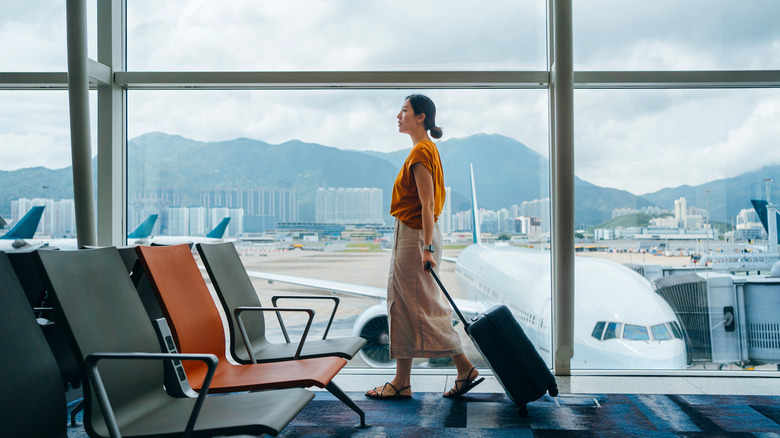Here's Why Airports Have Carpet Flooring Even Though Many Travelers Hate It
Have you ever found yourself trudging through an airport terminal, suitcase in tow, only to be confronted by an expanse of garish, seemingly outdated carpet? You're not alone. Airport carpeting has long been a source of bewilderment — and, let's face it, frustration — for plenty of travelers out there. With their busy patterns and questionable color choices that seem at odds with the sleek, modern aesthetics of air travel, carpets and airports go together like ... well, oil and water. However, despite the widespread disdain for all things carpet flooring, some airports continue to cover their gates and walkways in the plush material — leaving some travelers to push and pull their way through the inconvenience. But, it turns out, there is a reason for this choice that goes way beyond aesthetics.
So, what's the deal? Put simply, the airport carpet's role is to cut back on noise and improve acoustics — ultimately making for a more relaxed and comfortable experience for everyone. On top of that, there's one more reason you might not have guessed: Carpets (or, better yet, the feeling they inspire) also make travelers want to spend more money.
Carpets take airport comfort to the next level
As mentioned above, one of the main reasons airports opt for carpet flooring is because of its ability to significantly reduce noise levels. The soft, plush surface absorbs the sounds of countless footsteps and rolling suitcases that would otherwise create a cacophony on harder surfaces. This noise reduction ultimately contributes to a more peaceful atmosphere, which helps to bring down stress levels for even the most frazzled travelers.
However, the benefits of airport carpeting go way beyond just acoustics. In fact, there's also a subtle layer of consumer psychology at play here. Beyond being noise-dampening, the cozy, comfortable feeling when people step or sit on carpet can also have a profoundly calming effect on passengers' moods and behaviors. And, according to a study by the airport research experts at DKMA, when travelers feel more relaxed in their surroundings, they're also more likely to explore the terminal ... and potentially even spend more at the shops and restaurants.
Per DKMA, happy and relaxed travelers are actually twice as likely to shop while at the airport, with some shelling out 7% more on retail items and a whopping 10% more on duty-free products. By creating a more pleasant environment through simple choices like carpeting, airports aren't just improving the traveler experience — they're also boosting their bottom line in the long run.
Other airport design features to help soothe travelers
While carpeting plays a significant role, it's just one piece of a larger design puzzle. Gate areas, for instance, are often designed with lower ceilings than the main concourse. This creates a more intimate, less overwhelming space that helps passengers feel a little more at ease. From there, comfortable seating options — from traditional benches to more relaxed, lounge-style chairs — also contribute to a homey atmosphere. On top of that, many airports also prioritize natural lighting by incorporating large windows or skylights to brighten spaces, while some play with circadian lighting to mimic natural daylight patterns to keep travelers energized and in sync.
Beyond that, some airports have even taken extra measures and introduced a series of innovative and underrated amenities to keep travelers calm once they've crossed through security. Whether it's by implementing sleep pods travelers can rent for a quick power nap, creating designated yoga studios and even specialized "llama therapy" rooms to boost feelings of happiness, or simply offering massage and robot manicure services, airports are thinking outside the box.
After all, by transforming terminals from mere transit points into welcoming spaces where travelers are happy to linger — whether they're waiting for a connecting flight or just killing time before departure — airports can enhance the overall travel experience. And, let's be honest, who wouldn't want to enjoy a moment of zen while munching on some gateside snacks and watching planes take off at the same time?


